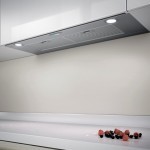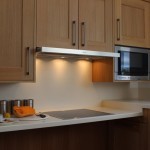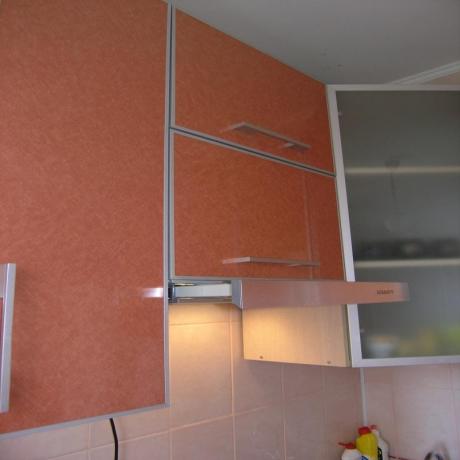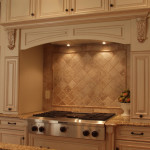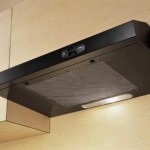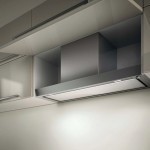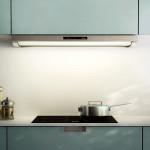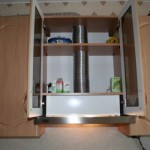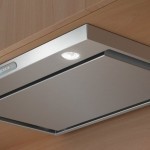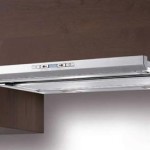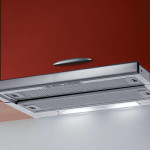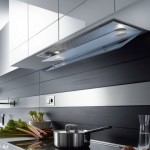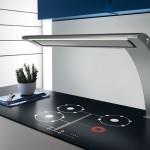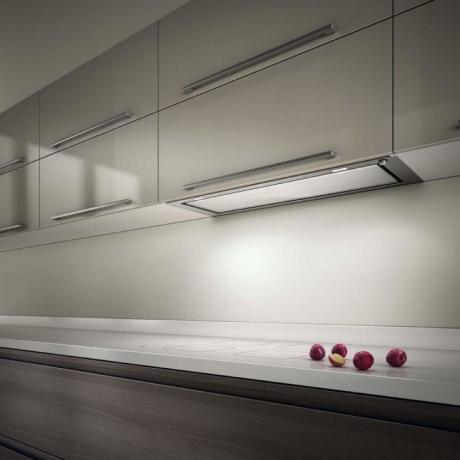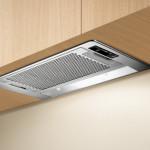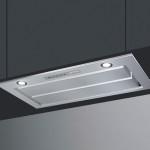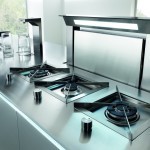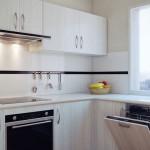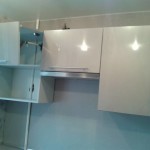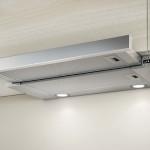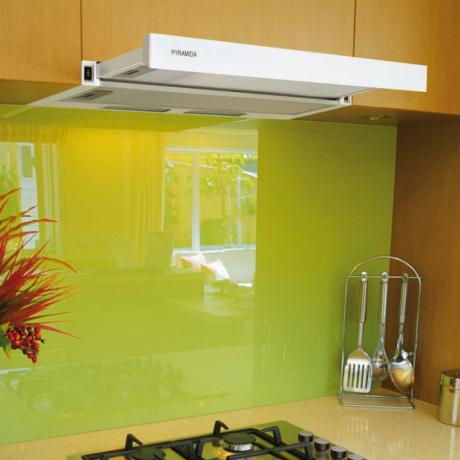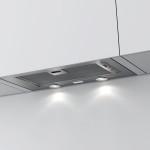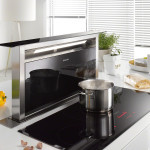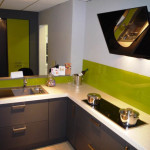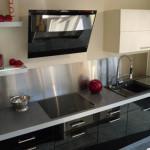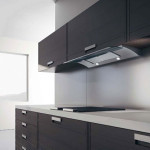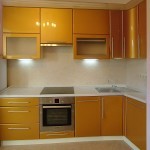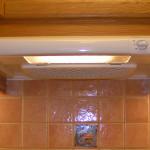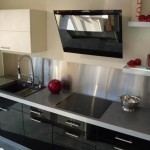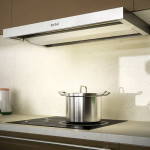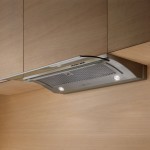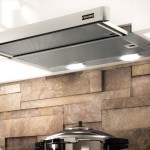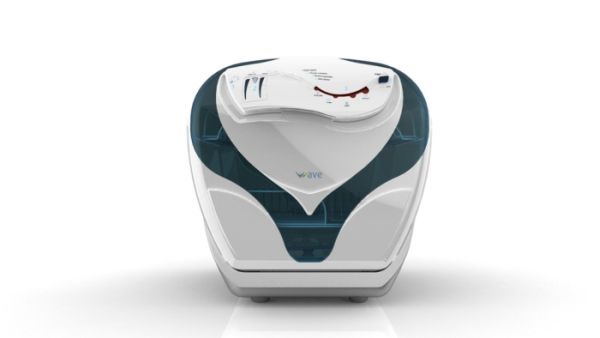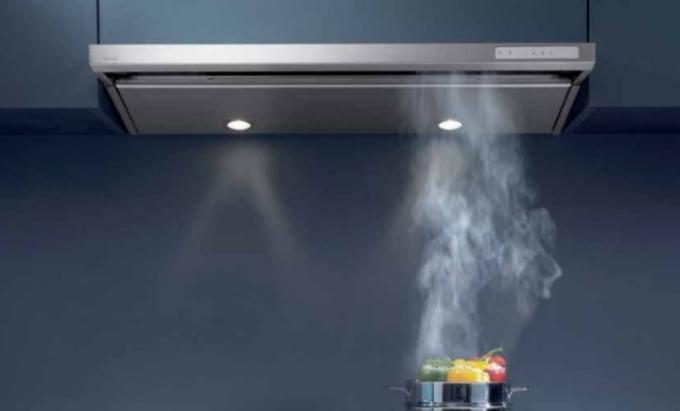Content
- 1 Application and purpose
- 2 Features of the choice of built-in hoods
- 3 Components
- 4 Design features or what to look for
-
5 Self-assembly of the built-in hood
- 5.1 What to consider
- 6 Finally
If you are not yet familiar with built-in appliances, now is the time to fill this gap and learn new knowledge. This type of technique is ideal for small domestic kitchens, in which there is not a centimeter of extra space, for the implementation of the most daring ideas of the hostesses.
Built-in kitchen hoods of 60 cm and 50 cm are ideal for those who prefer to use living space rationally without cluttering the aisles with bulky furniture and electrical equipment. Indeed, a lot depends on a good location (for example, the degree of comfortable work and the convenience of the kitchen as a whole).
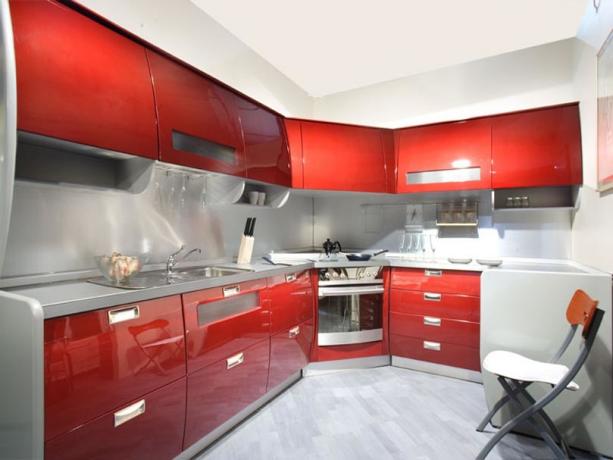
Fashionable kitchen with built-in cooker hood
Application and purpose
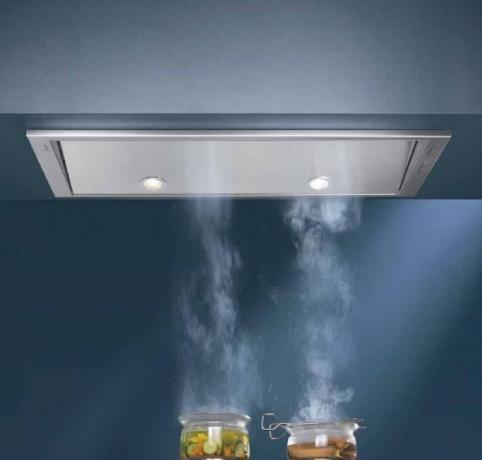
Built-in cooker hood - elegant and convenient
Built-in kitchen hoods are an especially important element of any kitchen. Thanks to the air circulation in the room, a pleasant and healthy atmosphere is created in which there are no unpleasant odors. The quality of air purification in the kitchen directly depends on the quality of the unit installed above the hob.
If you do not want other flavors to interrupt the smells from your cutlets, then it is vitally important for you to get a good built-in hood. In addition to purifying the air from odors and various harmful microelements, the hoods "dilute" the air with useful microparticles.
These trace elements can adversely affect not only the lungs, but also cause irritation of the mucous membrane of the nose and eyes. In the event that you have not an electric, but a gas stove, then you simply cannot do without a hood! Why? It's all the fault of carbon monoxide, which often becomes the cause of real tragedies caused by poisoning.
Features of the choice of built-in hoods
When choosing built-in kitchen hoods, you should remember the main criterion - performance. Productivity is the volume of air that the hood is able to pass through itself in one unit of time (usually the amount of cubic meters of air per 1 hour is measured).
Everything is quite easy to calculate: if you know the cubic capacity of the kitchen, then you can easily choose a suitable hood. We take the dimensions of the kitchen and the approximate operating time of the unit (in our case, the hoods) and compare the performance with the volume (see. also how to calculate the power of the hood for the kitchen).
If you don't understand, let's move on to the numbers: the size of the kitchen in a 1-room "Khrushchev" is about 22.5 m³; hood operation time - 30 minutes; high-quality extraction capacity - 400 m³ / hour. Based on these dimensions and indicators, this hood is able to cope with the ventilation of the above kitchen in 13-15 minutes.
It turns out that a model with this performance is perfect for "Khrushchev" cuisine!
But a high-quality built-in cooker hood is not only about high performance indicators.
When choosing a new unit, you should also pay attention to its type:
-
Diverting - are devices that simply suck in air and remove it outside the kitchen, and fresh air enters through the ventilation system;
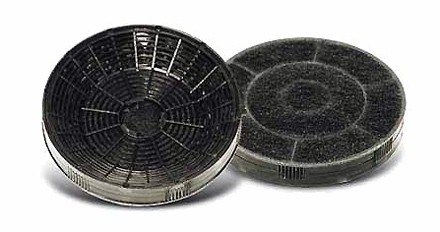
Branch hood diagram
- Circulating - kitchens that do not have good ventilation just need circulating cooker hoods without air duct. They circulate the air in the room, cleaning it from harmful elements and fat, which remains on the ceiling and wallpaper during cooking;
Attention!!!
There are other subspecies of built-in hoods that combine the elements of the two above types of devices.
If you are interested not so much in the technical side of the issue as in design, then you will certainly be pleasantly surprised that the built-in kitchen cooker hood is a pleasant variety of a rich assortment of products that differ not only in shapes, but also in colors and material.
You can always purchase an original built-in hood that will look great in combination with any headset.
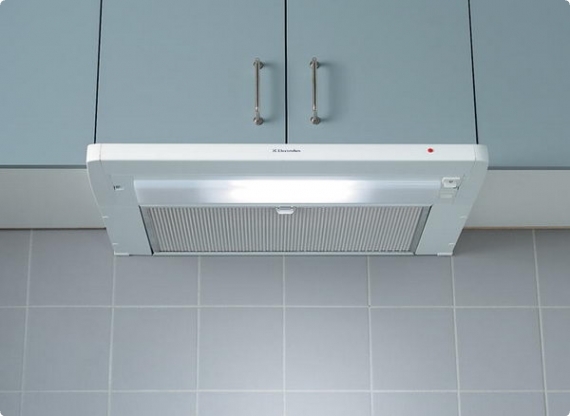
Concise version of the built-in hood

A very original solution for a modern kitchen

Unusual hood for a stylish kitchen

A more classic version
Components
There are some options that will also be useful for housewives: for example, an anti-return valve that prevents the penetration of street air (the air entering the apartment through the ventilation does not have pleasant refreshing properties and sometimes has simply disgusting smell).
The body is also an important element of the product. If it is not easily soiled, then the hostess will no longer need to wipe the panel and adjacent elements daily.
Backlight. For many chefs, light plays an important role (additional lights will help control the cooking process in a poorly lit room).

Hood with illumination
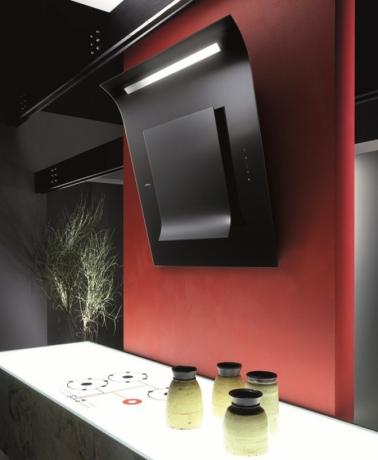
Exclusive backlit hood design
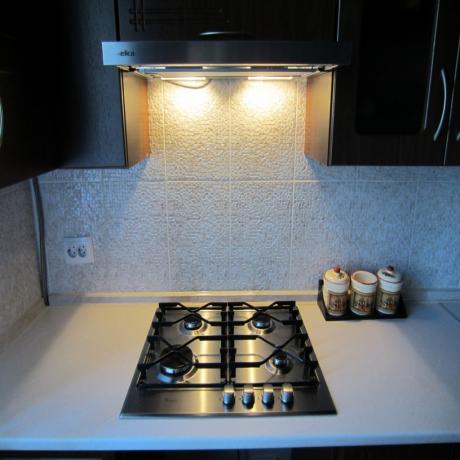
Functional built-in hood with lighting
Design features or what to look for
Built-in hoods practically do not affect the design of the room, therefore, perhaps, the main argument when buying a new built-in hood is its dimensions. First, pay special attention to cooker size - extractor hood should not be less than the size of the hob!
If the size of the hood is slightly larger than the size of your stove, it's okay, small deviations from the standard dimensions are permissible and will not affect the operation of the system as a whole.
When buying a new built-in hood, pay special attention to those models that have coarse and fine filters. For your information - filters for coarse cleaning are inherently grease traps. Their base is a mesh, which, if necessary, can be easily removed and washed with an ordinary cleaning agent.
Fine filters are designed to clean the air from harmful microelements and odor - in they are mainly used in the air recirculation mode, cleaning the room and at the same time keeping it warmly. Quite often, charcoal filters are not included in the standard built-in hood assembly, so the charcoal filter elements must be purchased separately.
Many modern hoods have a speed limit.
Please note !!!
The more speeds the hood has, the faster the fan rotates and, accordingly, the noise level increases.
You should not take super strong units - an 8-speed range hood will be able to satisfy the needs of even a small culinary workshop and will be a perfectly acceptable option for an ordinary kitchen.
In addition to the speeds, the hoods can have either one or two fans. But keep in mind that two small fans are much quieter than one large one.
Self-assembly of the built-in hood
If you decide to purchase a built-in hood, then you should worry in advance about the cabinet in which you will mount it. In general, such issues are resolved as they arise - when buying a new set, you should order a box above the stove without a bottom (specially adapted for the installation of the hood).
If you have some carpentry skills, then you can make a cabinet for the hood with your own hands, if Since the cabinet is already available, you can remove the bottom from it or cut out a special landing slot.
So let's get started.
If you have a locker, we start installing our hood:
- The first thing to start with is to study the mounting method. In general, built-in hoods are attached to the middle shelf of the cabinet, but in the absence of this, other methods of fastening can be considered. Next, we attach the hood and air duct, which is passed through special holes in the back or side wall.
- We mount the cabinet above the hob (stove). To do this, it is necessary to observe some of the dimensions indicated in the instructions for use and the purpose of this device (hood). There you will find the required distance between the hob and the hood.
- Separate socket. For proper and long-term operation of the built-in hood, it is necessary to install a separate earthed socket.
In some houses, grounding is quite problematic and resourceful owners ground the sockets from the electrical panel on the staircase. If you do not know how or if you think this method is impractical, that is, it is possible to "nullify" the outlet. For this, it is necessary to connect the grounding terminals of the socket to the "zero cable".
What to consider
Each built-in cooker hood has its own installation instructions defined by the manufacturer.
For each specific case (models and modifications), the manufacturer indicates the features and recommendations, the observance of which will allow the hood to be used for many years.
- The first rule for installing a built-in hood is that the pull-out panel of the hood must remain visible.
- The second unshakable rule is that the outlets must be properly connected to the ventilation shaft or specially made holes in the wall. As an option, many use circulation-type hoods, but experts recommend using such models only as a last resort.
- The third rule - strictly observe the dimensions indicated by the manufacturer (in this case, we mean the distance between the hob and the hood). In general, the average distance between the hood and the stove is 65-75 cm from the hob of the electric stove, and 70-80 cm from the surface of the gas stove.
In the event that the distance is less, there is a high probability of damage to your hood by open fire or very hot air. If the distance is large, then steam from pots and pans will simply not be sucked in and your hood will work idle.
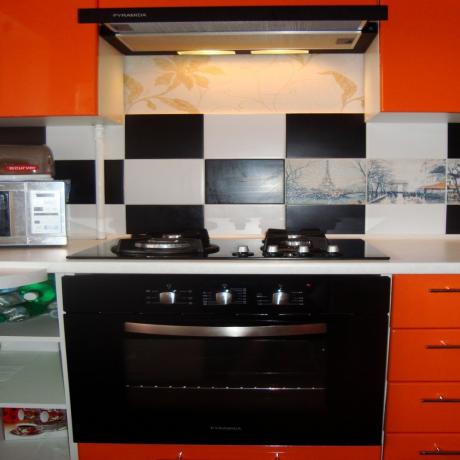
Example: the distance between the hood and the hob is observed
There are several opinions regarding the use of smooth and crimped sleeves. The main advantage of the corrugated sleeve is its flexibility: it can be easily bent at the desired angle without damaging its integrity.
Attention!!!
The bend angle of the corrugated sleeve should not exceed 90 °. If this norm is exceeded, the throughput of the air outlet will be significantly reduced, which will accordingly reduce the performance of the hood.
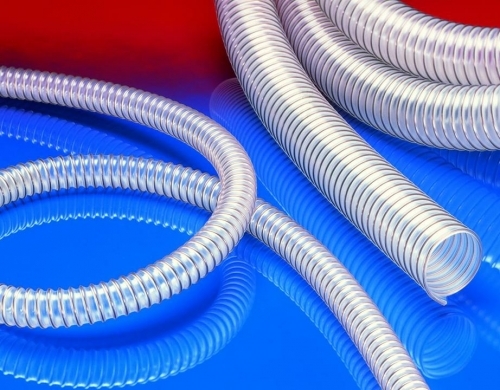
Pleated sleeves
There are several more disadvantages of corrugated sleeves:
- Ribbed walls increase noise levels;
- The ribbed surface increases the air resistance, which leads to a loss in the production capacity of the hood.
If we talk about smooth sleeves, then their main difficulty is installation. You will have to spend more than one hour cutting out intricate intricacies and over their fastening.
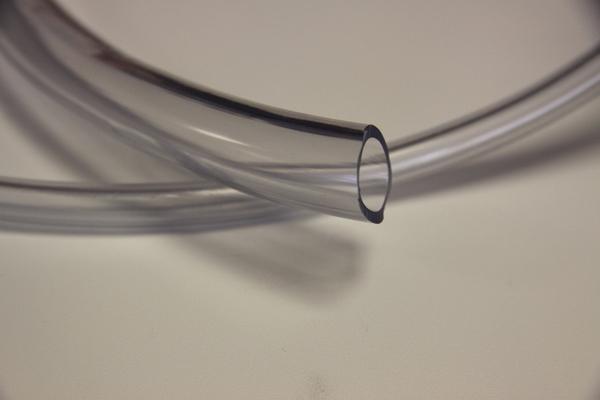
Smooth sleeves
Finally
In general, a kitchen with a built-in hood will greatly facilitate the life of any housewife, and will significantly save kitchen space. If you have any questions or something is not clear, then especially for you we have a photo and video instruction that will help not only with the choice of the hood, but also with the installation by hand. The price for built-in hoods is relatively low and everyone can afford such a "luxury"!
Gallery
